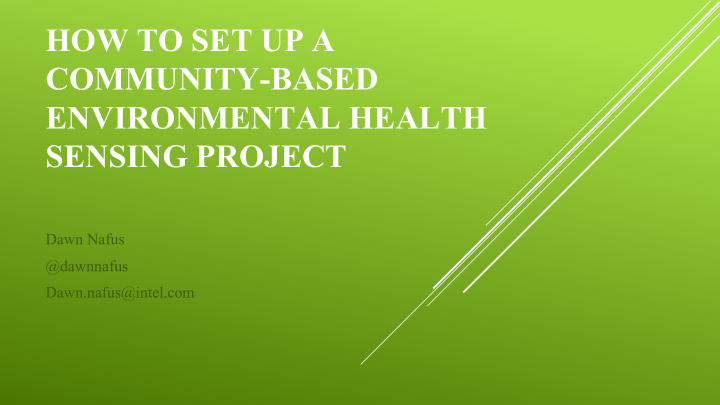



HOW TO SET UP A COMMUNITY-BASED ENVIRONMENTAL HEALTH SENSING PROJECT Dawn Nafus @dawnnafus Dawn.nafus@intel.com
WHY COMMUNITY? WHY ENVIRONMENT?
OUR SETUP (sort of) Fenceline.org →ESDR (and a bunch of other things we tried and got no signal)
PEOPLE WRANGLING ▶ Work with an organization, don’t go it alone ▶ Have a shared research design that participants had a hand in creating Supply 100x more tech support than you think you’ll need ▶ ▶ Create defined times & places ▶ To get kitted up ▶ To look at the data together (individuals & groups) Ensure that jointly all relevant skills are covered: ▶ Communication, sensor wrangling, data wrangling, action based on the findings ▶ As the QS person, it’s your job to do the tool vetting ▶ ▶ Time align! (and throw out the straggler days) Design for consent, for appropriate expectations, and for afterlife of data ▶
HARDWARE WRANGLING People sensing: Air Quality: Wearability/portability matters ▶ ▶ Official sensors →better pollutant variety, Apple/Android incompatibilities are a real ▶ worse spatial distribution, possibly worse problem or better cleaning Export is a real constraint ▶ ▶ Unofficial sensors→ PM 2.5 only, suffers ▶ People will do entries 2x/day for 2 months drift, but can achieve density but no more than that Watch out for when they leave the area ▶ ▶ Indoor vs outdoor N phenomenon exist, HR & SPO2 are ▶ promising Leave room for “here’s something else you ▶ should know”
DATA WRANGLING ▶ Point person in charge of getting it in the same analytic frame ▶ Correlations are tricky & loaded ▶ Data “giveback” is likely to be different than the analysis version ▶ You might need to do some interpretive innovation The “toxic soup index” ▶ An (accidental) N-of-many-ones visualization ▶
DATA GOTCHAS ▶ Beware the detection limit ▶ Beware the wind ▶ Beware the spatial distribution vs sensor density ▶ AQ usually is a low grade toxic soup, not a dramatic incident ▶ See Richmond Analysis in backup ▶ What actually correlates with air changes at what temporality is not well known even though in general we know air affects cardiovascular/pulmonary health Analysis of Richmond Air Data, Fair Tech Collective
HIGH LEVEL LEARNINGS 1. Community-driven doesn’t mean you can do away with experts entirely. 2. If you take the experts too seriously, you’ll never get anywhere. 3. People already know BOTH more than, and less than, you think they know. 4. Something wonderful happens when the individual can see themselves as part of the group. 8
FURTHER RESOURCES Making the Most of Air Monitoring and the Richmond Analysis from Fair Tech Collective ▶ An example of results report-back for participants. Note this phase had no conclusive results, and therefore the ▶ researcher had to explain why. https://publiclab.org/ An excellent organization on DIY environmental sensing ▶ ▶ https://www.silentspring.org/ Environmental health organization currently running a “Detox me” action kit for sensing toxins in urine→ org is analyzing aggregate results ▶ Air quality data repository with data export: https://esdr.cmucreatelab.org/browse/ https://www.specksensor.com/ CMU created fine particulate monitor, not optimized for outdoor use but good ▶ data access https://www.purpleair.com/ Fine particulate monitor, you have to ask nicely for the data but claims it stays in ▶ calibration @dawnnafus or dawn.nafus@intel.com --contact for slides
Recommend
More recommend